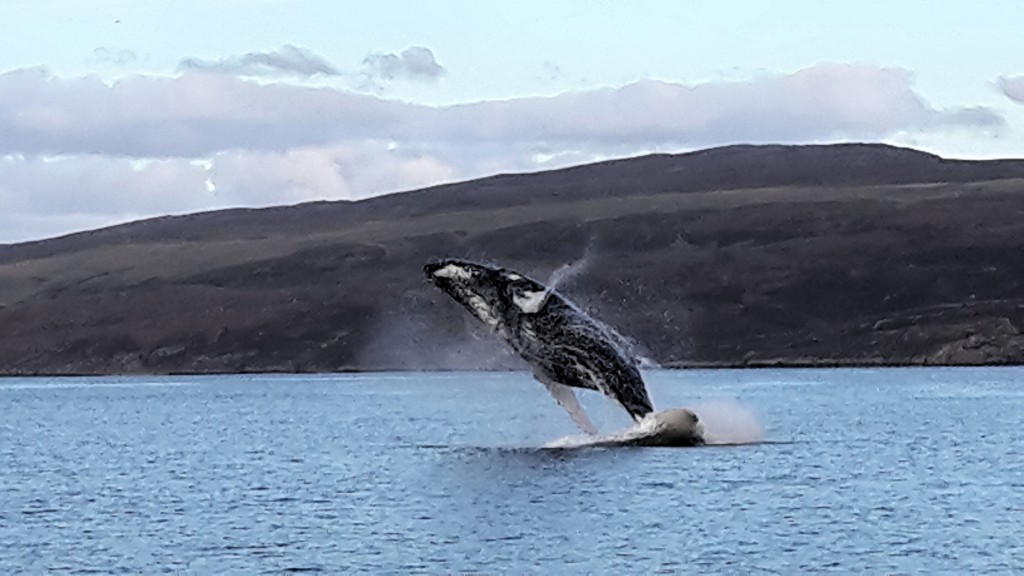Wildlife enthusiasts and members of the public around the coast of the British Isles are being treated to an unusually high number of sightings of one of the world’s most charismatic mammals, the humpback whale.
Reports, photographs and videos of humpbacks have been flooding in to the Sea Watch Foundation. The latest in a recent spate of humpback whale sightings took place just off one of the UK’s largest cities. Most famous for the ‘fab four’, its music scene and its football clubs, Liverpool can now add humpback whale to its list of interesting visitors! On Tuesday this week, local boat worker, Lee Sparks, filmed the distinctive pectoral fin slapping of a humpback as he helped guide large boats in and out of this world famous port. Lee sent in his video to Sea Watch Foundation. Sea Watch monitors whales, dolphins and porpoises (cetaceans) all around the British Isles. With the network of observers its Director set up over forty years ago, Sea Watch operates one of the first ‘citizen science’ schemes in the world, utilising cetacean sightings from the public to inform policy on how best to conserve these species given all the changes happening around our coasts. Now, it has nearly 200,000 records of whales, dolphins and porpoises

Photo 1: a humpback whale breach snapped on a mobile phone by fisherman Brian Wells in the Sound of Raasay last autumn.
“Sightings of both harbour porpoise and bottlenose dolphins seem to have increased in Liverpool Bay in the last few years, corresponding perhaps to an improvement in water quality as well as increased effort with more dedicated watches and surveys being conducted by our Regional Coordinators and local volunteers, but no one was expecting a humpback whale! In fact, this may well be the first live sighting of a humpback whale in Liverpool Bay on record but we will be delving into our historical archives to confirm! Either way, this is a very exciting sighting! ” explains Katrin Lohrengel, Monitoring Officer for Sea Watch Foundation and previously voluntary Regional Coordinator for Sea Watch operations in the North-west of England.
Video of Humpback whale sighting in Liverpool
Other recent humpback whale sightings include one off Aberdeen on 18th May, another between the Isles of Scilly and Cornwall on 28th May and yet another animal in the Sound of Raasay between Rona and Skye in the Inner Hebrides, west of Scotland on 7th June. Additionally, there have been several sightings in North-east Scotland in the past few weeks, including one stranded animal. Tragically, the stranded animal was entangled in fishing gear. This animal was thought to be the one that Sea Watch regional coordinator for the Moray Firth, Alan Airey, photographed close to shore at Bedbea near Berriedale, Caithness on 30 May. It was seen heading west and probably got caught in crab pot ropes not long after it was last seen. It was located from a RIB on Saturday, and, a few days later, was towed back to Helmsdale. Caithness Sea Watch recorder, Colin Bird reported that as many as six Humpbacks were seen during the Orca Watch week that he organised. He said “it’s the first time that I have seen this number of humpbacks while I have been sea watching, in the last 10 years – very unusual activity!”
Back on 12th April, there were unconfirmed reports of a humpback whale off the Norfolk coast and on 5th March an animal was seen in the English Channel not far from Dover in Kent, whilst on 18th April a humpback was seen off the east side of Foula in Shetland.
Stop press! Another humpback whale has been filmed off Dartmouth in Devon on June 29th! Click here to see the video.

Photo 2: an example of humpback tail fluke used for identification purposes. S Round / Sea Watch Foundation.
Scientists are able to identify individual humpbacks by patterns on their tail flukes. Using photographs from the sightings, Sea Watch Foundation can see if the animals have been recorded before by attempting to match them to a catalogue. This information helps to determine information such as how the animals use particular habitats, their range and life processes.
Humpback whales are not common in British waters, but are occasionally and increasingly being encountered off the west coast of Ireland and northern Scotland in summer, on their way from winter breeding grounds off the coasts of Africa to feeding grounds mainly around Iceland. For half a century, the species was extremely rare in British waters after a long history of over-exploitation. However, since the 1980’s, the species has been recorded regularly from Shetland, NE Scotland, the northern Irish Sea, and in the Western Approaches to the Channel.
“This recent spate of sightings also highlights the importance of citizen science and voluntary observers to charities such as ours. It shows that you don’t have to be an expert to get involved and make a difference. You just need to take a moment to report your sighting!” says Kathy James, Sightings Officer for the charity. “People from all over the UK can help us to monitor these incredible creatures by taking part in our National Whale and Dolphin Watch which starts next month” continues Kathy.
The National Whale and Dolphin Watch takes place from 25th July – 2nd August. You don’t need to have any experience to get involved. You can join organised watches or set up your own with some guidance from the team at Sea Watch Foundation. Please visit www.seawatchfoundation.org.uk/nwdw to find out more!
Sightings of whales, dolphins and porpoises can easily be submitted online at www.seawatchfoundation.org.uk/sightingsform/ and you can also find out more information about the work of the charity and download species fact files too.

























Pingback: Ten years after the Thames whale, how are Britain’s sea mammals faring? | StuntFM 97.3